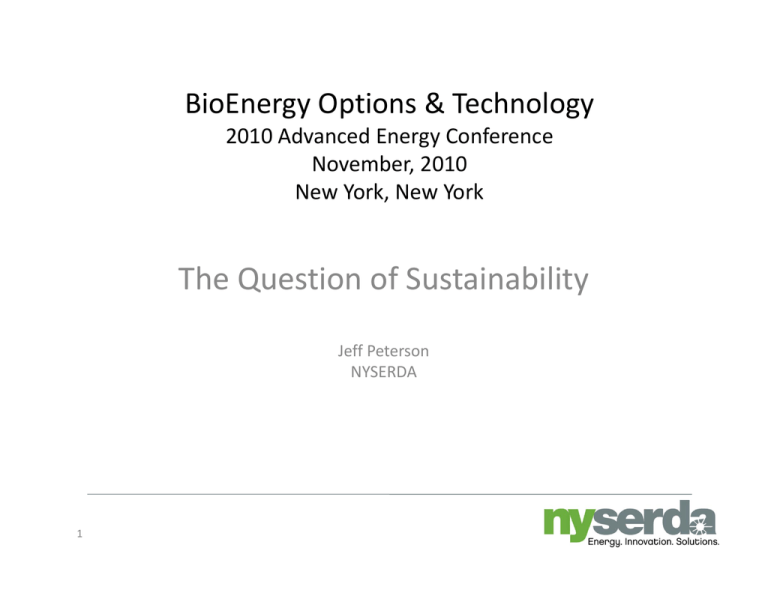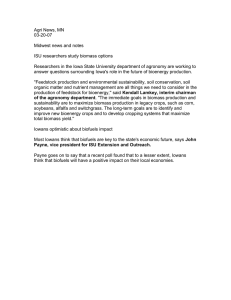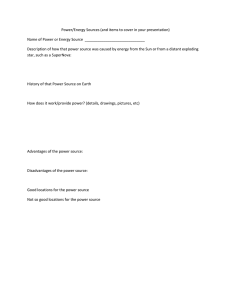The Question of Sustainability
advertisement

BioEnergy Options & Technology 2010 Advanced Energy Conference November, 2010 New York, New York The Question of Sustainability Jeff Peterson NYSERDA 1 Acknowledgments Renewable Fuels Roadmap and Sustainable Biomass Feedstock Supply for New York; Pace University Energy and Climate Center; White Plains, New York; Zywia Wojnar, Project Manager Appendix E: Analysis of Sustainable Feedstock Production Potential in New York State. Peter B. Woodbury; Sustainable Biomass Feedstock Supply Team Leader Cornell University Appendix K: Sustainability Criteria . Timothy A. Volk; Roadmap Sustainability Task Team Leader; State University of New York, College of Environmental Science and Forestry (SUNY‐ESF) Judy Jarnefeld; NYSERDA Project Manager for the Roadmap NYS Department of Environmental Conservation and NYS Department of Agriculture and Markets for cofunding the effort with NYSERDA. http://www.nyserda.org/publications/renewablefuelsroadmap/default.asp 2 Presentation Outline • Renewable Fuels Roadmap and Sustainable Feedstock Supply Study • Comparison of Roadmap Scenarios • Potential Sustainable Biomass Supply • Competing Uses • The question of sustainability 3 Renewable Fuels Roadmap and Sustainable Feedstock Supply Study Identified in the February 2008 Report of the New York Governor’s Renewable Energy Task Force, which called for a Renewable Fuels Roadmap and Sustainable Biomass Feedstock Study for New York (Roadmap). Key components identified by the Task Force: “critical environmental, capacity, technology, efficiency, and economic issues for renewable fuels.” Provide policymakers with the positive and negative impacts associated with the increased use and production of renewable fuels in the State, paying particular attention to environmental issues and public health. 4 Renewable Fuels Roadmap and Sustainable Feedstock Supply Study for New York Scenario Comparison Scenario Big Step Giant Leap Distributed Production Near‐term Advanced Advanced Energy crop area (million acres) 0.98 1.68 1.68 Perennial grasses & willow biomass (million dry tons – Mdt) 4.6 8.2 8.2 Forest biomass (Mdt) 4.8 6.4 6.4 4 4 4 4/~90 12/~354 22‐24/~60 Conversion technology Number of Feedstock Sheds Number of Biorefineries/Avg Capacity (million gallons/year ‐ MGY) 5 Biorefinery Siting Maps Siting map for lignocellulosic biorefineries projected for scenario 3 (below). Siting map for lignocellulosic biorefineries projected for scenarios 1 and 2 (above). 6 Land and Feedstock Availability • Between 1 million and 1.68 million acres of non‐forest land may be available for bioenergy feedstock production • Nearly 15.8 million acres of forest land (timberland) producing or capable of producing woody biomass • New York could sustainably produce between 4.2 ‐ 14.6 million dry tons of cellulosic biomass per year 7 Current and Potential Competing Uses for Biomass 8 Sustainability Criteria • Sustainability is value‐based (technical aspects of criteria can be answered by experts but criteria ranking depends on norms) • 35 criteria generally discussed in bioenergy sustainability assessment across the globe were presented to ~400 NY stakeholders to assess their importance with respect to NY biofuels • While ‘Natural Resource Efficiency' is ranked high in importance, all criteria were considered fairly equally important across a range of stakeholders • Developing guidelines on how to assess these criteria may be a priority to assess sustainability of biofuels in NY. • "Participation", "Monitoring of Criteria Performance", "Food Security", and most notably, "Property Rights and Rights of Use" are seen as difficult to assess at this point and need efforts to improve their monitoring. • The criteria "Respect for Human Rights", "Standard of Living", "Land Use Change", and "Energy Balance“ lack an existing legal and/or regulatory framework in NY. 9 A Sample of Sustainability Research Questions • Greenhouse gas emissions from feedstock production, including nitrous oxide emissions from fields and soil carbon sequestration in soil. • Environmental impacts of feedstock cultivation over large areas, potential for offsite migration of nutrients. • Direct and indirect land use change. • Large‐scale production impacts, such as pests, for dedicated feedstock crops. • Impact of large‐scale biomass harvest from existing forests on species diversity. • Effect of increased truck traffic on local, state, and interstate transportation networks and the quality of life in rural areas. • Assess trends in land development projects (housing/business) for competition of land resources identified in this study. • Assess environmental impacts from overall system energy use and environmental impact across local and global scales so the positive and negative externalities of local sourcing can be compared to the externalities of outsourcing fuel resources. 10



